
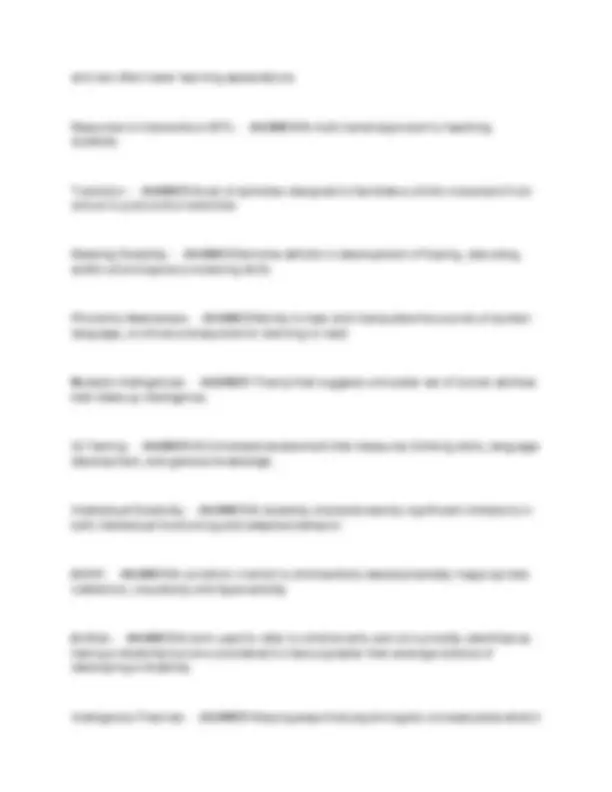
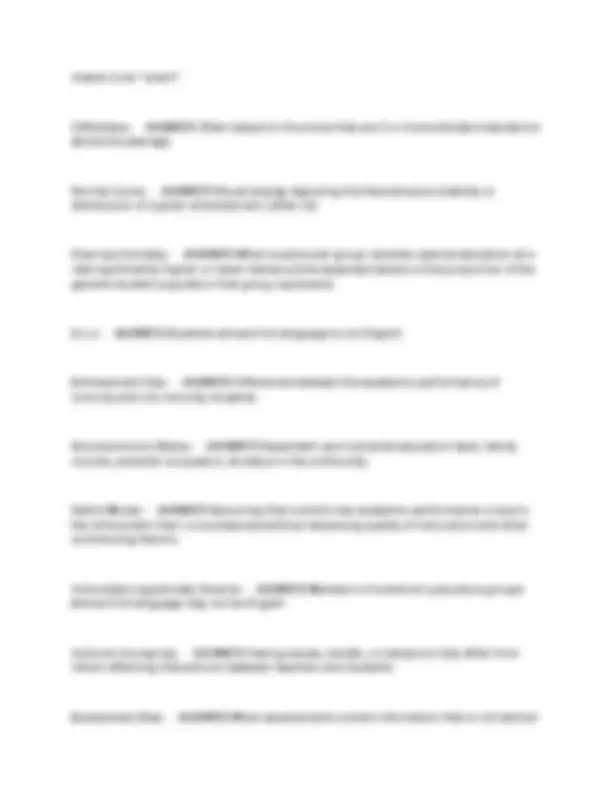
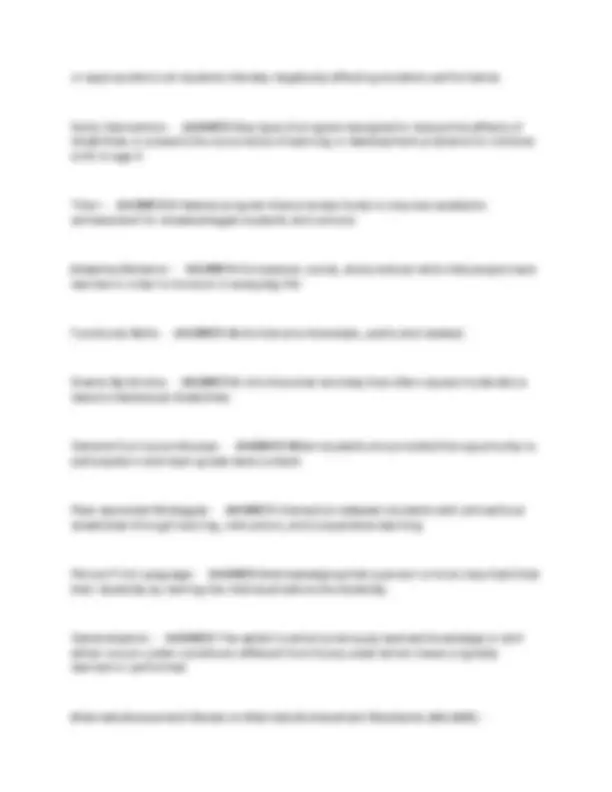
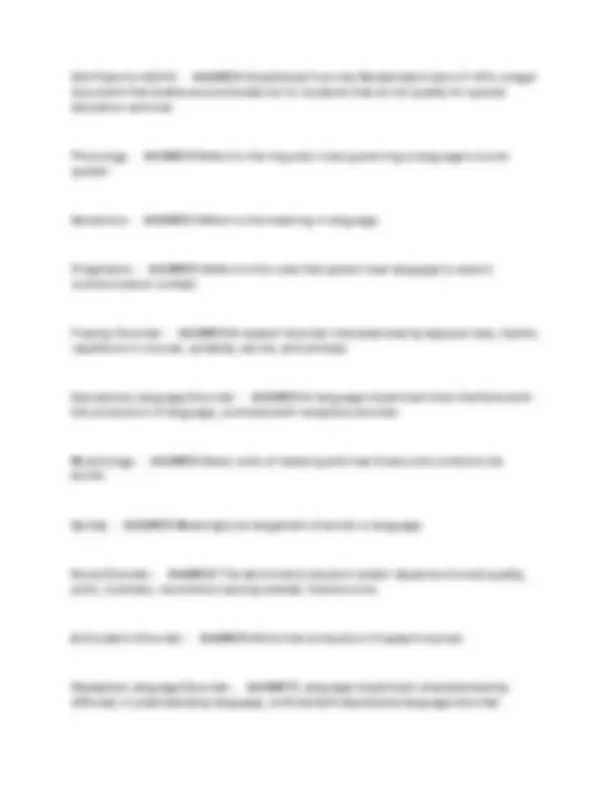

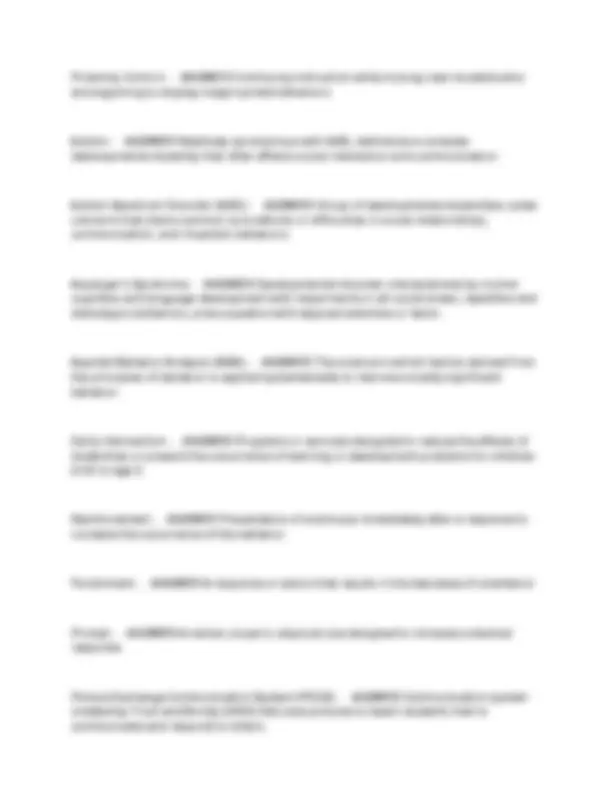
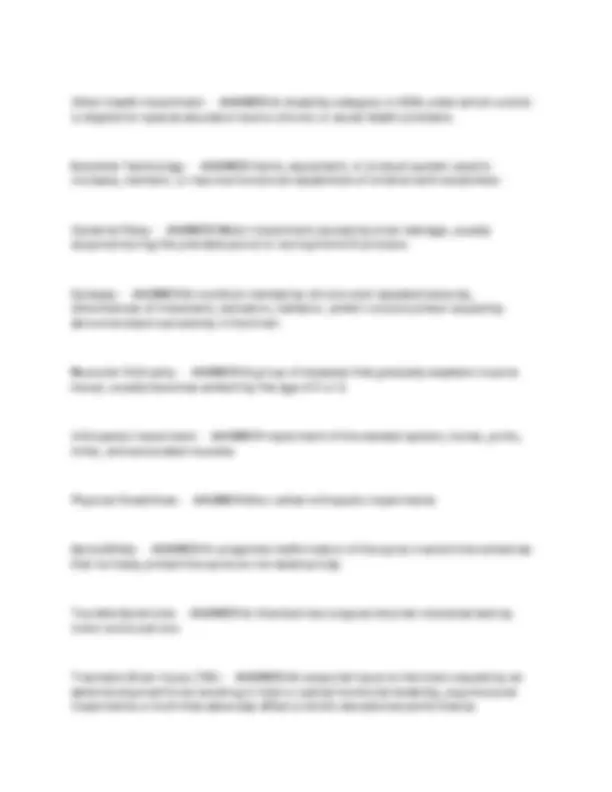
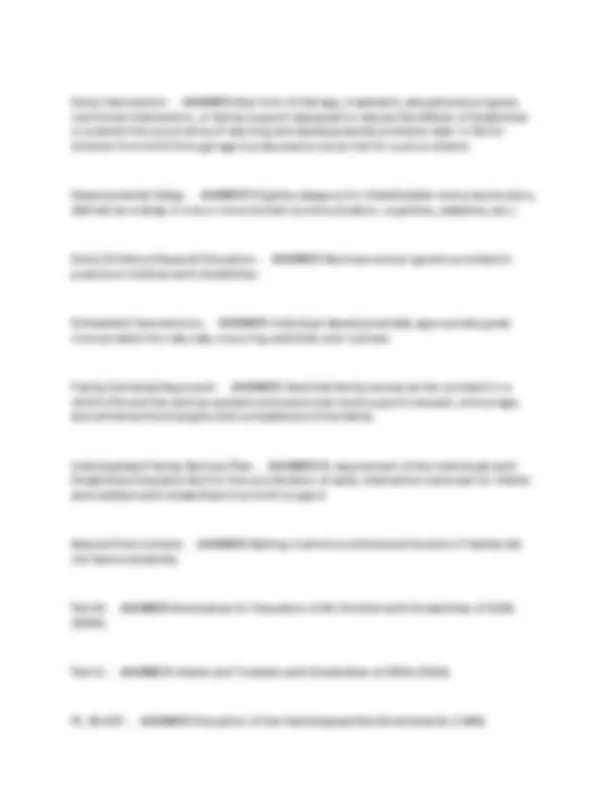


Study with the several resources on Docsity

Earn points by helping other students or get them with a premium plan


Prepare for your exams
Study with the several resources on Docsity

Earn points to download
Earn points by helping other students or get them with a premium plan
Community
Ask the community for help and clear up your study doubts
Discover the best universities in your country according to Docsity users
Free resources
Download our free guides on studying techniques, anxiety management strategies, and thesis advice from Docsity tutors
SPED 2100 Final Exam Review 100% Verified!!
Typology: Exams
1 / 14

This page cannot be seen from the preview
Don't miss anything!









Least Restrictive Environment (LRE) - ANSWER The educational setting that most closely resembles a regular school program and also meets the child's special education needs.
Inclusion - ANSWER Educating students with disabilities in general education classrooms.
Special Education - ANSWER Individually planned, specialized, intensive, outcome-directed instruction.
Individualized Education Plan (IEP) - ANSWER A written document required by the Individuals with Disabilities Education Act (PL-94-142) for every child with a disability.
Disability - ANSWER A condition characterized by functional limitations that impede typical development as the result of a physical or sensory impairment or difficulty in learning or social development.
Zero Reject - ANSWER Principle established by IDEA preventing public schools from denying access to educational experiences.
Exceptionality - ANSWER Characteristic where performance deviates from the norm, either below or above, from the mainstream population.
Continuum of Services - ANSWER A range of placement and instructional options for children with disabilities, ranging from general education to separate settings, home or hospital depending on the severity and intensity of the needs of the student.
Individualities with Disabilities Education Act (IDEA) - ANSWER An education Act, reauthorized by congress and the Bush Administration in 2004, which provides a foundation of rights and services for children with disabilities.
Free Appropriate Public Education (FAPE) - ANSWER Schools must provide each qualifying child with disabilities a program of education and related services at no cost to the child's parents or guardians.
Individualized Family Service Plan (IFSP) - ANSWER Required by IDEA, a plan that coordinates early intervention services for infants and toddlers with disabilities from birth to age 3.
504 Plan - ANSWER An accommodation plan for students with disabilities that do not qualify for special education services.
Consultation - ANSWER A special education teacher provides support to regular education teachers and staff regarding the needs of students but does not provide direct services for students.
Resource Room - ANSWER A place where students work with a special education teacher to receive direct attention to academic skills in a small group setting.
Self-Contained Classroom - ANSWER A classroom typically located in a regular public school that includes only children with exceptionalities.
Accomodations - ANSWER Adjustments to the classroom instruction or assessment so students with disabilities have access to the same curriculum standards as their peers without disabilities.
Co-Teaching - ANSWER Format in which a regular education and special education teacher plan and conduct lessons in the general classroom.
Modifications - ANSWER Changes in the content material that alter or reduce material
means to be "smart".
Giftedness - ANSWER Often based on IQ scores that are 2 or more standard deviations above the average.
Normal Curve - ANSWER Visual display depicting the theoretical probability or distribution of a given characteristic (often IQ).
Disproportionality - ANSWER When a particular group receives special education at a rate significantly higher or lower that would be expected based on the proportion of the general student population that group represents.
ELLs - ANSWER Students whose first language is not English
Achievement Gap - ANSWER Difference between the academic performance of minority and non-minority students.
Socioeconomic Status - ANSWER Dependent upon parental education level, family income, parental occupation, & status in the community.
Deficit Model - ANSWER Assuming that a child's low academic performance is due to the child and/or their circumstances without assessing quality of instruction and other contributing factors.
Culturally/Linguistically Diverse - ANSWER Members of a distinct subculture groups whose first language may not be English.
Cultural Incongruity - ANSWER Having values, beliefs, or behaviors that differ from others affecting interactions between teachers and students.
Assessment Bias - ANSWER When assessments contain information that is not familiar
or appropriate to all students thereby negatively affecting students performance.
Early Intervention - ANSWER Any type of program designed to reduce the effects of disabilities or prevent the occurrence of learning or development problems for children birth to age 5.
Title I - ANSWER A federal program that provides funds to improve academic achievement for disadvantaged students and schools.
Adaptive Behavior - ANSWER Conceptual, social, and practical skills that people have learned in order to function in everyday life.
Functional Skills - ANSWER Skills that are immediate, useful and needed.
Downs Syndrome - ANSWER A chromosomal anomaly that often causes moderate to severe intellectual disabilities.
General Curriculum Access - ANSWER When students are provided the opportunity to participate in and learn grade level content.
Peer-assissted Strategies - ANSWER Interaction between students with and without disabilities through tutoring, instruction, and cooperative learning.
Person First Language - ANSWER Acknowledging that a person is more important than their disability by naming the individual before the disability.
Generalization - ANSWER The extent to which previously learned knowledge or skill either occurs under conditions different from those under which it was originally learned or performed.
Alternate Assessment Based on Alternate Achievement Standards (AA-AAS) -
associated with a learning disability.
Exclusionary Definition - ANSWER Suggests that the SLD is based on the exclusion of multiple factors that could logically explain a student's failure in school.
Learning Strategy Instruction - ANSWER Explicit instruction in strategies such as reading, writing, test taking to promote academic success.
Inattentivness - ANSWER Inability to focus on a targeted task.
Hyperactivity - ANSWER Excessive motor activity or restlessness.
Impulsivity - ANSWER Lack of ability to think through consequences of actions.
Dopamine - ANSWER Neurotransmitter associated with ADHD.
Neurotransmitter - ANSWER Enables brain cells to communicate through synapses.
Chronicity - ANSWER Behavior present over an extended period of time.
Stimulant - ANSWER Known to increase the actions of the central nervous system, medications often used in the treatment of ADHD.
Executive Functioning - ANSWER The brain's ability to focus, self-monitor, and pay attention as a child makes plans and thinks them through.
Comorbidity - ANSWER Two or more conditions occurring in the same person (e.g. ADHD and SLD).
504 Plans for ADHD - ANSWER Established from the Rehabilitation Act of 1973, a legal document that enable accommodations for students that do not qualify for special education services.
Phonology - ANSWER Refers to the linguistic rules governing a language's sound system.
Semantics - ANSWER Refers to the meaning in language.
Pragmatics - ANSWER Refers to the rules that govern how language is used in communication context.
Fluency Disorder - ANSWER A speech disorder characterized by atypical rate, rhythm, repetitions in sounds, syllables, words, and phrases.
Expressive Language Disorder - ANSWER A language impairment that interferes with the production of language, contrasts with receptive disorder.
Morphology - ANSWER Basic units of meaning and how those units combine into words.
Syntax - ANSWER Meaningful arrangement of words in language.
Voice Disorder - ANSWER The abnormal production and/or absence of vocal quality, pitch, loudness, resonance causing a weak, hoarse voice.
Articulation Disorder - ANSWER Abnormal production of speech sounds.
Receptive Language Disorder - ANSWER Language impairment characterized by difficulty in understanding language, contrast with expressive language disorder.
Proximity Control - ANSWER Continuing instruction while moving near students who are beginning to display inappropriate behaviors.
Autism - ANSWER Relatively synonymous with ASD, defined as a complex developmental disability that often affects social interaction and communication.
Autism Spectrum Disorder (ASD) - ANSWER Group of developmental disabilities under one term that share common core deficits or difficulties in social relationships, communication, and ritualistic behaviors.
Asperger's Syndrome - ANSWER Developmental disorder characterized by normal cognitive and language development with impairments in all social areas, repetitive and stereotypic behaviors, preoccupation with atypical activities or items.
Applied Behavior Analysis (ABA) - ANSWER The science in which tactics derived from the principles of behavior is applied systematically to improve socially significant behavior.
Early Intervention - ANSWER Programs or services designed to reduce the effects of disabilities or prevent the occurrence of learning or development problems for children birth to age 5.
Reinforcement - ANSWER Presentation of a stimulus immediately after a response to increase the occurrence of the behavior.
Punishment - ANSWER A response or action that results in the decrease of a behavior.
Prompt - ANSWER A verbal, visual or physical cue designed to increase a desired response.
Picture Exchange Communication System (PECS) - ANSWER Communication system created by Frost and Bondy (2002) that uses pictures to teach students how to communicate and respond to others.
Generalization - ANSWER The extent to which previously learned knowledge or skill either occurs under conditions different from those under which it was originally learned or performed
Audiogram - ANSWER A graph of the faintest level of sound a person can hear in each ear at least 50% of the time at each of several frequencies.
Total Communication - ANSWER An approach to educating deaf students that combines oral speech, sign language, and fingerspelling.
Audiometer - ANSWER A device that generates sounds at specific frequencies and intensities; used to examine hearing.
Audiology - ANSWER The science of hearing.
Decibel - ANSWER The unit of measure for the relative intensity of sound on a logarithmic scale beginning at zero.
Conductive Hearing Loss - ANSWER Hearing loss caused by obstructions in the outer or middle ear or malformations that interfere with the conduction of sound waves to the inner ear.
Ottis Media - ANSWER An infection or inflammation of the middle ear that can cause conductive hearing loss.
Cochlear Implant - ANSWER A surgically implanted device that converts sound from the environment into electric impulses that are sent directly to the brain via the auditory nerve.
Sensironeural Hearing Loss - ANSWER A hearing loss caused by damage to the auditory nerve or the inner ear.
Other Health Impairment - ANSWER A disability category in IDEA under which a child is eligible for special education due to chronic or acute health problems.
Assistive Technology - ANSWER Items, equipment, or product system used to increase, maintain, or improve functional capabilities of children with disabilities.
Cerebral Palsy - ANSWER Motor impairment caused by brain damage, usually acquired during the prenatal period or during the birth process.
Epilepsy - ANSWER A condition marked by chronic and repeated seizures, disturbances of movement, sensation, behavior, and/or consciousness caused by abnormal electrical activity in the brain.
Muscular Distrophy - ANSWER A group of diseases that gradually weakens muscle tissue; usually becomes evident by the age of 4 or 5.
Orthopedic Impairment - ANSWER Impairment of the skeletal system, bones, joints, limbs, and associated muscles.
Physical Disabilities - ANSWER Also called orthopedic impairments.
Spina Bifida - ANSWER A congenital malformation of the spine in which the vertebrae that normally protect the spine do not develop fully.
Tourette Syndrome - ANSWER A inherited neurological disorder characterized by motor and vocal tics.
Traumatic Brain Injury (TBI) - ANSWER An acquired injury to the brain caused by an external physical force resulting in total or partial functional disability, psychosocial impairments or both that adversely affect a child's educational performance.
Early Intervention - ANSWER Any form of therapy, treatment, educational program, nutritional intervention, or family support designed to reduce the effects of disabilities or prevent the occurrence of learning and developmental problems later in life for children from birth through age 5 presumed to be at risk for such problems.
Developmental Delay - ANSWER Eligible category for infant/toddler and preschoolers, defined as a delay in one or more domain (communication, cognitive, adaptive, etc.)
Early Childhood Special Education - ANSWER Services and programs provided to preschool children with disabilities.
Embedded Interventions - ANSWER Individual developmentally appropriate goals incorporated into naturally occurring activities and routines.
Family-Centered Approach - ANSWER Idea that family serves as the constant in a child's life and the service systems and personnel must support,respect, encourage, and enhance the strengths and competence of the family.
Individualized Family Service Plan - ANSWER A requirement of the Individuals with Disabilities Education Act for the coordination of early intervention services for infants and toddlers with disabilities from birth to age 3.
Natural Environment - ANSWER Setting in which a child would function if he/she did not have a disability.
Part B - ANSWER Assistance for Education of All Children with Disabilities of IDEA (2004).
Part C - ANSWER Infants and Toddlers with Disabilities of IDEA (2004).
PL 99-457 - ANSWER Education of the Handicapped Act Amendments (1986).